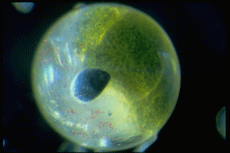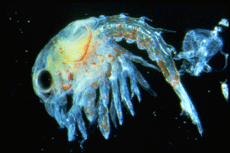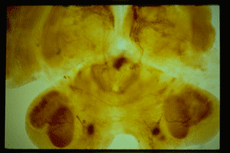Development
When the Beltz Lab was first established at Wellesley College in 1987, we planned to study how serotonin influences neuronal development, using the lobster as our animal of choice. The appearance of serotonin immunoreactivity in the lobster nervous system during embryonic and larval development had already been examined, and we knew that serotonin was among the earliest of the transmitters to appear-as in many vertebrate systems (Beltz et al., 1990). One advantage of using the lobster nervous system to study serotonergic influences during development is the presence of two giant serotonergic neurons (>100 micrometers soma diameter, even in hatchlings) that densely innervate the olfactory and accessory lobes in the brain. These large dorsal giant neurons [DGNs] are born at ~30% embryogenesis, and aspects of their development coincide with defined events in brain differentiation (Beltz et al., 1992). Therefore, we hypothesized that the DGNs might act as developmental architects, shaping the differentiation of their targets. In order to examine these types of questions, we first had to learn about the development of the lobster--- from fertilization through embryonic, larval and juvenile stages. Our early publications describing lobster embryonic development resulted in a quantitative staging system for embryos (Helluy and Beltz, 1991), which we subsequently used to launch carefully controlled studies testing whether brain development in the lobster was altered by pharmacological depletion of serotonin. These experiments used the selective serotonin toxin 5,7-dihydroxytryptamine, administered chronically to lobster embryos, to examine the effects of dramatically reduced levels of serotonin on the growth and differentiation of the brain (Benton et al., 1997).
|
Home | Links | Contact Us
- Maintained by: Barbara Beltz & Jeannie Benton
- Created: June 2, 2006
- Last Modified: June 2, 2006
- Expires: June 2, 2006


